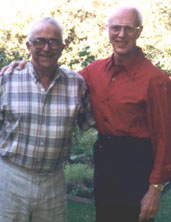I first got to know Glenn when we were both assigned to Luke Field, Arizona, for Advanced Flight Training. While he was down the alphabet some distance from me and, therefore, we were housed in different barracks, we became good friends during the time we were there. Our flight training started in At-6s, then moved up to P-40s — our first actual combat fighter plane. On January 7, 1944 we marched up the same platform to receive our pilot wings, and to be commissioned as 2ndLieutenants. We then were assigned to Harding Field at Baton Rouge to transition into P-47 Thunderbolts. In early May 1944 we shipped out for England on the U.S.S. Brazil, heading for the war in Europe.

I was assigned to the 366th Fighter Group, and Glenn went to the 362nd Fighter Group, 377th Fighter Squadron. We both ended up flying from landing strips in France shortly after the invasion of Normandy. The following notes were made while I was talking to Glenn by telephone in 1996:
“From the time I first went into combat, I could see that the odds were great that I would ultimately be shot down. Each night while lying on my cot, I would review the procedure for bailing out. I wanted to have everything clearly fixed in my mind, so the process would be as close to automatic as possible.
“On August 8, 1944, I was flying at 13,000 feet on a mission near Paris, when I was hit by 88mm flak. Oil covered my canopy, and it was apparent I was going down. Doing things exactly as I had planned, I trimmed the plane to roll left, then dived head first out the right side. The next thing I knew, I was trapped in a vacuum under the belly of the plane – which was apparently created by the prop wash and air coming over the top of the wing. Oil was all over me and the plane, and I had to get my hands and knees against the belly of the plane and push myself off. I landed on a small haystack, and within a short period of time I was picked up by the Germans. Unfortunately, they were members of the SS, and instead of being sent to a POW camp, I was sent to the concentration camp at Buchenwald.
“Eighty-one other American airmen were held there. On two occasions I was told that I would be shot the next morning; they would go through the whole process of preparing for the execution, then change their minds. At the end of three months I was nothing but skin and bones, and felt I was approaching death. Then the Luftwaffe interceded, and all of the Americans at Buchenwald were transferred to Stalag Luft 3. With the approach of Russian and American forces in late April 1945, we were all able to walk away to safety. But I am still haunted by those events in 1944 and 1945.”
– Glenn Horwege
I last saw Glenn on July 10, 1996, when I went to Sacramento, CA to have dinner with him and his family. We had a wonderful evening, reviewing those days so long ago. For those few hours we were once again young fighter pilots, remembering the buddies we had lost and the amazing events of our wartime lives. The photograph below was taken by Glenn’s wife, Sandy, on that evening of July 10, 1996 at their home.
Glenn had been fighting cancer, and a few months later it again struck him. He died about six months later. But I will always remember him as he was, when we went through flight training and shipped overseas together. His incredible stories about bailing out of his P-47, and his time in Buchenwald are truly unique. Such was the world in which we lived.

